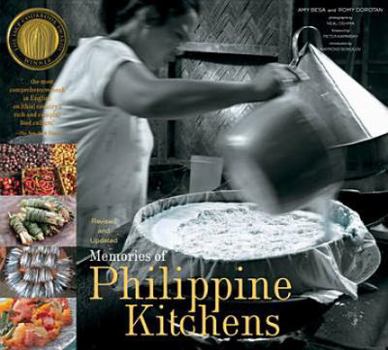Memories of Philippine Kitchens
Select Format
Select Condition 
Book Overview
The essence of Filipino food has always remained somewhat secluded in the family kitchens of Filipino homes, passed down through the generations, melding native traditions with those of Chinese,... This description may be from another edition of this product.
Format:Paperback
Language:English
ISBN:1584799811
ISBN13:9781584799818
Release Date:May 2012
Publisher:Harry N. Abrams
Length:240 Pages
Weight:0.30 lbs.
Dimensions:0.9" x 10.0" x 9.0"
Customer Reviews
4 ratings
High Expectations and Better Than I Imaged
Published by Thriftbooks.com User , 17 years ago
My wife is from the Philippines. I saw this book on the IACP Cookbook Awards Finalist list and thought she would enjoy a book containing recipes for some of the Philippine cuisine she hasn't cooked herself. Received the book today and expected it to be good, but it is even better than I imagined. There are many many fine color photographs with few text only pages and recipes for everything I've heard my wife mention over the years. I most enjoy cookbooks that go into the culture and history as well as providing top quality photographs, recipes, best practices, examples, etc. This book appears to have it all!
A scholarly anthropology
Published by Thriftbooks.com User , 17 years ago
One thing must be made clear: "Memories ..." is not cookbook. Yes, the authors, who happen to be the proprietors of Cendrillon in New York, provide good recipes for many of the important Filipino dishes. But the book is much more a scholarly anthropology of what is perhaps the least understood of Asia's great cuisines. It tells you which dishes are truly indigenous, which ones are borrowed and adapted from Spain and Mexico and which ones are from Asian neighbors. The authors also tell you about wonderful personalities in the Philippines who produce dishes to die for. There is the master lechonero of Silay and the famous puto maker of Pila. There is even a bit of adventure -- they take you along in the hunt for the very elusive Kurakding, more rare and better tasting apparently than the white truffle of Piedmont! A fun book for intelligent foodies!
Delicious memories
Published by Thriftbooks.com User , 17 years ago
This book brings about a sense of nostalgia that is very pleasing. The variations in the classic recepies are most welcome and they do work for me. This book is very much worth it even if you do not know how to cook because the stories and history lessons make a great read. It is very well researched.
Excellent Study and Memoir of Filipino Cuisine. Buy It.
Published by Thriftbooks.com User , 17 years ago
`Memories of Philippine Kitchens' by husband and wife restaurateurs, Amy Besa and Romy Dorotan is, with a few important differences, cut from the same mold as the two latest books from another husband and wife team, writer Naomi Duguid and photographer Jeffrey Alford. The major difference is that while Duguid and Alford are exceptionally talented journalistic `outsiders', Besa and Dorotan are writing from well inside the Philippine cuisine, both being natives of the Philippines, albeit now working in a Manhattan restaurant specializing in Philippine cuisine. I'm especially interested in this book, as I lived and cooked in a Philippine household for almost three years, with my first experience being that old war-horse, `The Philippine Cookbook' by Reynaldo Alejandro, from whom I got my first adobo, pancit, lumpia, and sinigang recipes. This period in my life also rekindled my interest in cooking, and my first impressions of the Philippine cuisine compared to those of France, Italy, China, India, and even Mexico and Thailand is that it seemed a bit monochromatic. Oddly, I felt the same way about Irish cooking. This may not be as odd as it seems, as both cuisines are heavily based on a white starchy food, rice for the Philippines and the potato for Ireland. The centerpiece of our Philippine kitchen was a rather large hamper for dispensing rice which could easily hold 50 pounds of rice, which we bought in 25 pound bags, three to four at a time. And, one bag generally lasted about three weeks, as a rice cooker full of rice was made at virtually every meal. This impression of low variety was reinforced by visits to Philippine restaurants in New York and San Francisco. It is no surprise that our favorite restaurant was not Philippine, but Korean. Philippine cuisine almost seems like the anti-Mediterranean cuisine, with no cheese, wine, citrus, or tomatoes to speak of, and little wheat based culture. And, the primary vinegar seems to be apple rather than grape. Like the dozen or more Irish cookbooks I have reviewed, this title goes a long, long way to dispel the notion that Philippine food is uninteresting. Not only do the authors give us a great selection of recipes and heartfelt, firsthand stories of their Philippine families, friends, and sources, the book is organized in exactly the right way to best refresh my memories of this cuisine and introduce the cuisine to people who may have not yet experienced it. It is far, far better than the Alejandro volume and the other Philippine source I have reviewed, `Filipino Cuisine' by Gerry Gelle. In spite of the differences, it is no surprise that all three books begin with recipes for adobo, the one Philippine dish that is known around the world. It is no surprise that Raymond Sokolov, the eminent New York culinary journalist, who also did the Introduction to this book, put chicken adobo as one of his 101 most important recipes in `The Cook's Canon'. Fortunately, Besa and Dorotan give us a whole new approa




